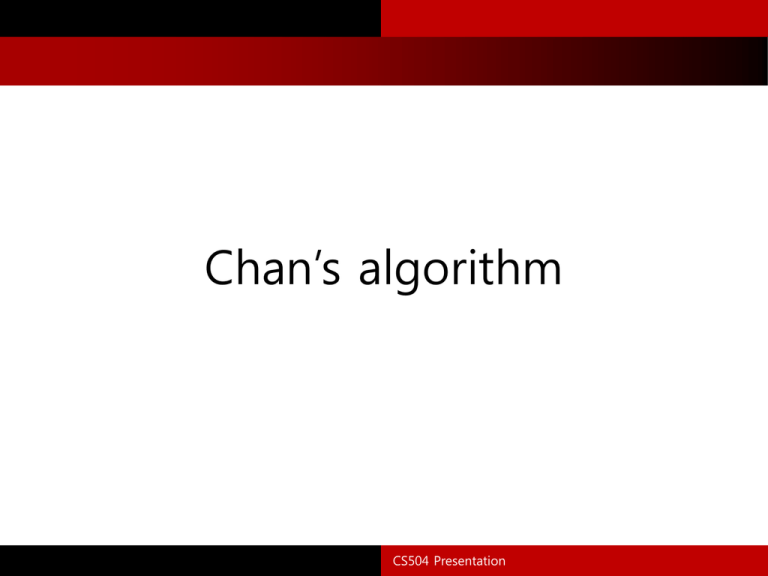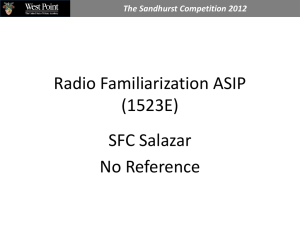Chan`sAlgorithm
advertisement

Chan’s algorithm CS504 Presentation Planar Convex Hull • Graham’s Scan : 𝑂(𝑛 log 𝑛) • Jarvis’s March : 𝑂(𝑛ℎ) • Is there any 𝑂(𝑛 log ℎ) algorithm? CS504 Presentation Chan’s Algorithm • Chan’s algorithm – combining Graham’s scan and Jarvis’s March together – 𝑂 𝑛 log ℎ • 3 stages of Chan’s algorithm 1. 2. 3. divide vertices into partitions apply Graham’s scan on each partition apply Jarvis’s March on the small convex hull (repeat 1~3 until we find the hull) CS504 Presentation Chan’s Algorithm • Stage1 : Partition • Consider arbitrary value 𝑚 < 𝑛, the size of partition – how to decide 𝑚 will be treated later • Partition the points into groups, each of size 𝑚 – 𝑟= 𝑛 𝑚 is the number of groups CS504 Presentation Chan’s Algorithm • Stage 1 n = 32 Set m = 8 CS504 Presentation Chan’s Algorithm • Stage 1 n = 32 Set m = 8 r=4 CS504 Presentation Chan’s Algorithm • Stage2 : Graham’s Scan • Compute convex hull of each partition using Graham’s scan • Total 𝑂(𝑛 log 𝑚) time CS504 Presentation Chan’s Algorithm • Stage 2 (After Stage 1) m=8 r=4 CS504 Presentation Chan’s Algorithm • Stage 2 Using Graham’s Scan O 𝑚 log 𝑚 for each group -> total 𝑂(𝑚𝑟 log 𝑚) = 𝑂(𝑛 log 𝑚) CS504 Presentation Chan’s Algorithm • Stage3 : Jarvis’s March • How to merge these r hulls into a single hull? • IDEA : treat each hull as a “fat point” and run Jarvis’s March! • # of iteration is at most m – to guarantee the time complexity O(nlogh) CS504 Presentation Chan’s Algorithm • (-inf,0) -> lowest pt (−∞, 0) lowest pt CS504 Presentation Chan’s Algorithm • Find the point that maximize the angle in each hull (−∞, 0) 1 lowest pt CS504 Presentation Chan’s Algorithm • Find the point that maximize the angle in each hull (−∞, 0) 2 1 lowest pt CS504 Presentation Chan’s Algorithm • Find the point that maximize the angle in each hull 3 (−∞, 0) 2 1 lowest pt CS504 Presentation Chan’s Algorithm If 𝑚 < ℎ, then the algorithm will fail! CS504 Presentation Chan’s Algorithm • FAIL EXAMPLE – too small value m m=4 (−∞, 0) 4 iteration CS504 Presentation Chan’s Algorithm In 4(a), how to find such points? CS504 Presentation Chan’s Algorithm • Find the point that maximize the angle in each hull (−∞, 0) 1 lowest pt CS504 Presentation Chan’s Algorithm • Find the point that maximize the angle in a hull (−∞, 0) CS504 Presentation Chan’s Algorithm • Finding tangent between a point and a convex 𝑚-gon 5 1 𝑂 log 𝑚 process 4 3 2 CS504 Presentation Chan’s Algorithm → 𝑂(log 𝑚) CS504 Presentation Chan’s Algorithm Analysis • Suppose God told you some good value for 𝑚 – ℎ ≤ 𝑚 ≤ ℎ2 • 𝑂 𝑛 log 𝑚 for stage1~2 • At most h steps in Jarvis’s March – 𝑂(log 𝑚) time to compute each tangent – 𝑟 tangent for each iteration 𝑛 – total 𝑂 ℎ𝑟 log 𝑚 = 𝑂(ℎ 𝑚 log 𝑚) time • 𝑂 𝑛+ℎ 𝑛 𝑚 log 𝑚 = 𝑂 𝑛 log 𝑚 = 𝑂(𝑛 log ℎ) as desired. 𝑚 ≤ ℎ2 CS504 Presentation Chan’s Algorithm • The only question remaining is… how do we know what value to give to 𝑚? CS504 Presentation Chan’s Algorithm • Answer : square search • Try this way - 𝑚 = 𝑡 2 2, 4, 8, … , 2 , … • Then we eventually get 𝑚 to be in [ℎ, ℎ2 ] ! CS504 Presentation Chan’s Algorithm • The algorithm stops as soon as 𝑡 2 2 ≥ℎ – 𝑡 = lg lg ℎ • Total time complexity lg lg ℎ lg lg ℎ 𝑛 log 2 𝑡=1 2𝑡 𝑛2𝑡 ≤ 𝑛 21+lg lg ℎ = 2𝑛 2lg lg ℎ = 𝑡=1 = 2𝑛 log ℎ = 𝑂(𝑛 log ℎ) CS504 Presentation









